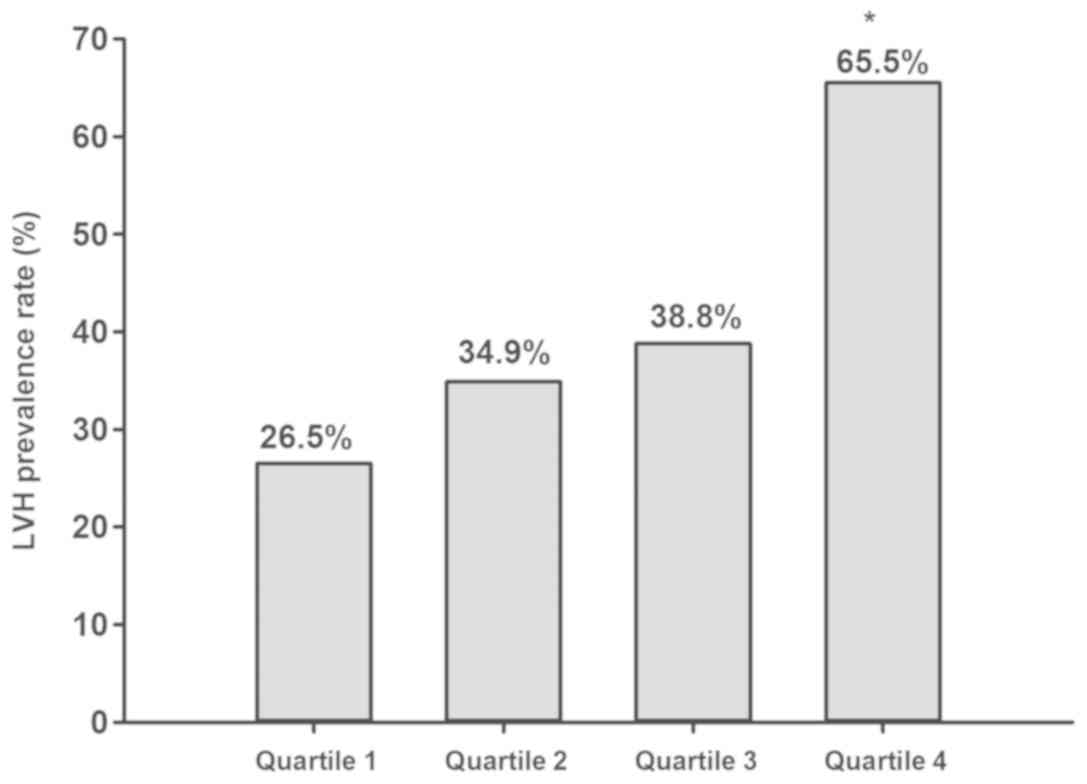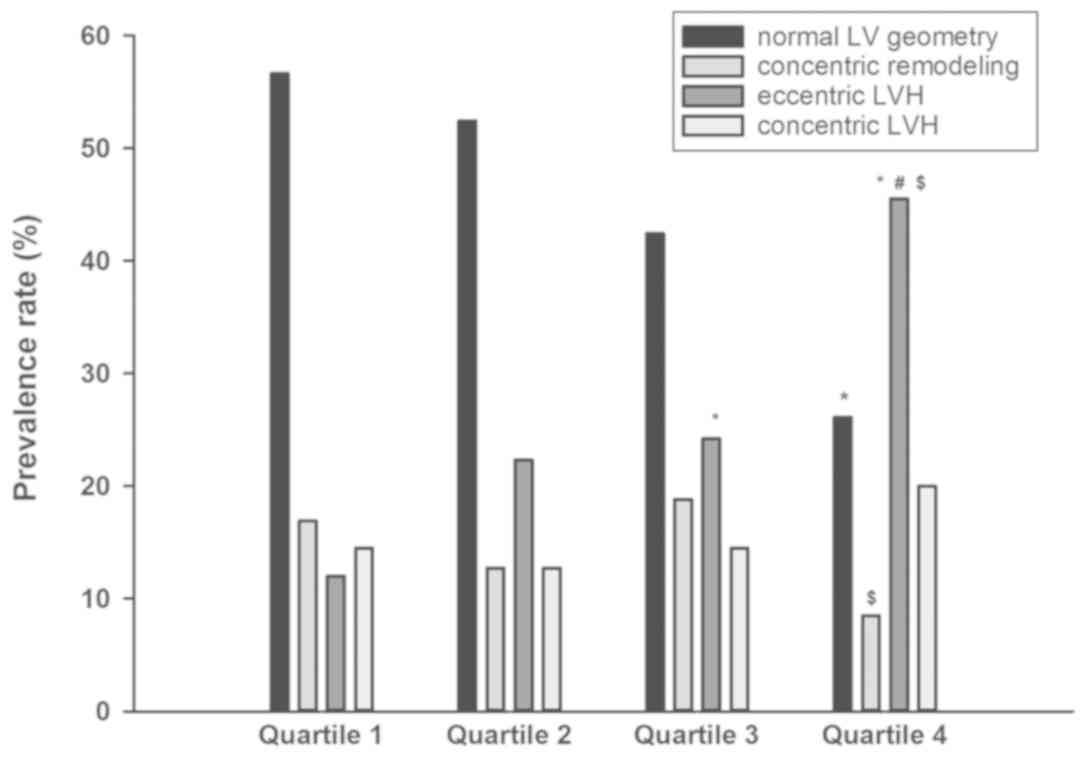|
1
|
de Lemos JA, McGuire DK and Drazner MH:
B-type natriuretic peptide in cardiovascular disease. Lancet.
362:316–322. 2003.PubMed/NCBI View Article : Google Scholar
|
|
2
|
Gupta DK and Wang TJ: Natriuretic peptides
and cardiometabolic health. Circ J. 79:1647–1655. 2015.PubMed/NCBI View Article : Google Scholar
|
|
3
|
Santaguida PL, Don-Wauchope AC, Oremus M,
McKelvie R, Ali U, Hill SA, Balion C, Booth RA, Brown JA, Bustamam
A, et al: BNP and NT-probNP as prognostic markers in persons with
acute decompensated heart failure: A systematic review. Heart Fail
Rev. 19:453–470. 2014.PubMed/NCBI View Article : Google Scholar
|
|
4
|
Ponikowski P, Voors AA, Anker SD, Bueno H,
Cleland JG, Coats AJ, Falk V, González-Juanatey JR, Harjola VP,
Jankowska EA, et al: 2016 ESC guidelines for the diagnosis and
treatment of acute and chronic heart failure. Kardiol Pol.
74:1037–1147. 2016.(In Polish). PubMed/NCBI View Article : Google Scholar
|
|
5
|
Morillas P, Castillo J, Quiles J, Nuñez D,
Guillén S, Maceira A, Rivera M and Bertomeu V: Usefulness of
NT-probNP level for diagnosing left ventricular hypertrophy in
hypertensive patients. A cardiac magnetic resonance study. Rev Esp
Cardiol. 61:972–975. 2008.(In English, Spanish). PubMed/NCBI
|
|
6
|
Rivera Otero JM, Taléns-Visconti R,
Salvador A, Bertomeu V, Miró V, Jordán A, Sogorb F, Cortés R, Payá
R, Diago JL, et al: Ventricular hypertrophy increases NT-proBNP in
subjects with and without hypertension. Int J Cardiol. 96:265–271.
2004.PubMed/NCBI View Article : Google Scholar
|
|
7
|
Parekh N and Maisel AS: Utility of
β-natriuretic peptide in the evaluation of left ventricular
diastolic function and diastolic heart failure. Curr Opin Cardiol.
24:155–160. 2009.PubMed/NCBI View Article : Google Scholar
|
|
8
|
Lubien E, DeMaria A, Krishnaswamy P,
Clopton P, Koon J, Kazanegra R, Gardetto N, Wanner E and Maisel AS:
Utility of B-natriuretic peptide in detecting diastolic
dysfunction: Comparison with doppler velocity recordings.
Circulation. 105:595–601. 2002.PubMed/NCBI View Article : Google Scholar
|
|
9
|
Santosa YP, Tjandrawati A, Noormartany
Erwinanto, Yahya AF, Martanto E, Tedjokusumo P, Purnomowati A and
Antono E: Comparison of pro β-natriuretic peptide in hypertensive
patients with and without diastolic dysfunction. Acta Med Indones.
40:19–23. 2008.PubMed/NCBI
|
|
10
|
Chinese Society of Cardiology of Chinese
Medical Association; Editorial Board of Chinese Journal of
Cardiology: Chinese guidelines for the diagnosis and treatment of
heart failure 2014. Zhonghua Xin Xue Guan Bing Za Zhi 42: 98-122,
2014 (In Chinese).
|
|
11
|
Lang RM, Bierig M, Devereux RB,
Flachskampf FA, Foster E, Pellikka PA, Picard MH, Roman MJ, Seward
J, Shanewise JS, et al: Recommendations for chamber quantification:
A report from the American society of echocardiography's guidelines
and standards committee and the chamber quantification writing
group, developed in conjunction with the European association of
echocardiography, a branch of the European society of cardiology. J
Am Soc Echocardiogr. 18:1440–1463. 2005.PubMed/NCBI View Article : Google Scholar
|
|
12
|
Liu LS: Writing Group of Chinese
Guidelines for the Management of Hypertension: 2010 Chinese
guidelines for the management of hypertension. Zhonghua Xin Xue
Guan Bing Za Zhi. 39:579–615. 2011.(In Chinese). PubMed/NCBI
|
|
13
|
Gebker R, Mirelis JG, Jahnke C, Hucko T,
Manka R, Hamdan A, Schnackenburg B, Fleck E and Paetsch I:
Influence of left ventricular hypertrophy and geometry on
diagnostic accuracy of wall motion and perfusion magnetic resonance
during dobutamine stress. Circ Cardiovasc Imaging. 3:507–514.
2010.PubMed/NCBI View Article : Google Scholar
|
|
14
|
Huang L, Teng T, Bian B, Yao W, Yu X, Wang
Z, Xu Z and Sun Y: Zinc levels in left ventricular hypertrophy.
Biol Trace Elem Res. 176:48–55. 2017.PubMed/NCBI View Article : Google Scholar
|
|
15
|
Yamazaki M, Ogawa T, Tamei N, Ando Y and
Nitta K: Relation of N-terminal pro-B-type natriuretic peptide
(NT-proBNP) and left atrial volume index to left ventricular
function in chronic hemodialysis patients. Heart Vessels.
26:421–427. 2011.PubMed/NCBI View Article : Google Scholar
|
|
16
|
Slubowska K, Sadowska A, Kwiatkowski A and
Durlik M: N-terminal pro-B-type natriuretic peptide (NT-proBNP)
assessment in the first year after renal transplantation and its
relationship with graft function and left ventricular hypertrophy.
Transplant Proc. 46:2729–2732. 2014.PubMed/NCBI View Article : Google Scholar
|
|
17
|
David S, Kümpers P, Seidler V, Biertz F,
Haller H and Fliser D: Diagnostic value of N-terminal pro-B-type
natriuretic peptide (NT-proBNP) for left ventricular dysfunction in
patients with chronic kidney disease stage 5 on haemodialysis.
Nephrol Dial Transplant. 23:1370–1377. 2008.PubMed/NCBI View Article : Google Scholar
|
|
18
|
Rivera M, Taléns-Visconti R, Salvador A,
Bertomeu V, Miró V, García de Burgos F, Climent V, Cortés R, Payá
R, Pérez-Boscá JL, et al: NT-proBNP levels and hypertension. Their
importance in the diagnosis of heart failure. Rev Esp Cardiol.
57:396–402. 2004.(In Spanish). PubMed/NCBI
|
|
19
|
Freitag MH, Larson MG, Levy D, Benjamin
EJ, Wang TJ, Leip EP, Wilson PW and Vasan RS: Framingham Heart
Study: Plasma brain natriuretic peptide levels and blood pressure
tracking in the framingham heart study. Hypertension. 41:978–983.
2003.PubMed/NCBI View Article : Google Scholar
|
|
20
|
Bower JK, Lazo M, Matsushita K, Rubin J,
Hoogeveen RC, Ballantyne CM and Selvin E: N-terminal pro-brain
natriuretic peptide (NT-proBNP) and risk of hypertension in the
atherosclerosis risk in communities (ARIC) study. Am J Hypertens.
28:1262–1266. 2015.PubMed/NCBI View Article : Google Scholar
|
|
21
|
Masiha S, Sundstrom J and Lind L:
Inflammatory markers are associated with left ventricular
hypertrophy and diastolic dysfunction in a population-based sample
of elderly men and women. J Hum Hypertens. 27:13–17.
2013.PubMed/NCBI View Article : Google Scholar
|
|
22
|
Erten Y, Tulmac M, Derici U, Pasaoglu H,
Altok Reis K, Bali M, Arinsoy T, Cengel A and Sindel S: An
association between inflammatory state and left ventricular
hypertrophy in hemodialysis patients. Ren Fail. 27:581–589.
2005.PubMed/NCBI View Article : Google Scholar
|
|
23
|
Zhao L, Cheng G, Jin R, Afzal MR, Samanta
A, Xuan YT, Girgis M, Elias HK, Zhu Y, Davani A, et al: Deletion of
interleukin-6 attenuates pressure overload-induced left ventricular
hypertrophy and dysfunction. Circ Res. 118:1918–1929.
2016.PubMed/NCBI View Article : Google Scholar
|
|
24
|
Phelan D, Watson C, Martos R, Collier P,
Patle A, Donnelly S, Ledwidge M, Baugh J and McDonald K: Modest
elevation in BNP in asymptomatic hypertensive patients reflects
sub-clinical cardiac remodeling, inflammation and extracellular
matrix changes. PLoS One. 7(e49259)2012.PubMed/NCBI View Article : Google Scholar
|
|
25
|
Kapoun AM, Liang F, O'Young G, Damm DL,
Quon D, White RT, Munson K, Lam A, Schreiner GF and Protter AA:
B-type natriuretic peptide exerts broad functional opposition to
transforming growth factor-beta in primary human cardiac
fibroblasts: Fibrosis, myofibroblast conversion, proliferation, and
inflammation. Circ Res. 94:453–461. 2004.PubMed/NCBI View Article : Google Scholar
|
|
26
|
Tamura N, Ogawa Y, Chusho H, Nakamura K,
Nakao K, Suda M, Kasahara M, Hashimoto R, Katsuura G, Mukoyama M,
et al: Cardiac fibrosis in mice lacking brain natriuretic peptide.
Proc Natl Acad Sci USA. 97:4239–4244. 2000.PubMed/NCBI View Article : Google Scholar
|
|
27
|
Rossi MA: Pathologic fibrosis and
connective tissue matrix in left ventricular hypertrophy due to
chronic arterial hypertension in humans. J Hypertens. 16:1031–1041.
1998.PubMed/NCBI View Article : Google Scholar
|
|
28
|
Ciulla M, Paliotti R, Hess DB, Tjahja E,
Campbell SE, Magrini F and Weber KT: Echocardiographic patterns of
myocardial fibrosis in hypertensive patients: Endomyocardial biopsy
versus ultrasonic tissue characterization. J Am Soc Echocardiogr.
10:657–664. 1997.PubMed/NCBI View Article : Google Scholar
|
|
29
|
Diez J, Querejeta R, López B, González A,
Larman M and Martínez Ubago JL: Losartan-dependent regression of
myocardial fibrosis is associated with reduction of left
ventricular chamber stiffness in hypertensive patients.
Circulation. 105:2512–2517. 2002.PubMed/NCBI View Article : Google Scholar
|
|
30
|
Brilla CG, Funck RC and Rupp H:
Lisinopril-mediated regression of myocardial fibrosis in patients
with hypertensive heart disease. Circulation. 102:1388–1393.
2000.PubMed/NCBI View Article : Google Scholar
|














